The Great Escape - Bali, A Gift From the GodsPrepared by Harold Stephens
Travel Correspondent for Thai Airways International
There's a saying about Bali: one week there is not enough; two weeks and it's too long; if it’s two weeks you're hooked forever. It's true, once you really get to know Bali, it's like Hemingway's "Moveable Feast," it never lets you go.
And what is it about Bali that has created this aura? I like to call it “mood.” Bali is a mood as well as a place. And it’s for this reason, the mood, that Royal Orchid Holidays placed Bali on its list of The Great Escapes.
I discovered this mood back in the 1960s, when Thai Airways decided to fly to the island, the first international airline to do so, and sent me ahead to do a series of travel articles to let the world know what Bali was all about. To reach Bali I had to travel by train overland from Jakarta.
The train carried me from Jakarta to Surabaya, and from there by bus to Banyuwangi in eastern Java. I caught the ferry to Gilimanuk by crossing the narrow strait that separates Java from Bali. As I stood at the railing and watched the green mountains of Bali draw closer my excitement grew. What was ahead? I knew I would like Bali when I disembarked from the ferry in Gilimanuk and boarded a bus and an old woman began tossing flower petals over the front of the vehicle. That was only the start; during the five-hour bus trip to Denpasar we must have passed through a half dozen villages that were celebrating with festivals of some sort or another. Even the very air we breathed was filled with the scent of flowers.
Once upon a time, everyone who came to Bali stayed in Denpasar. The reason—there were few other places to stay. I checked into a hotel in town before going to the Bali Beach Hotel, to get a kind of feel for the place. The hotel immediately captured my attention, not for its ambience but for its sense of history. It was the Natour Bali, once called the Bali Hotel. It dates from Dutch days. It was a pleasantly old-fashioned place with a restaurant that was true to the East Indies colonial style. They served the same rijstaffel as they did for the Dutch before the war.
I was anxious to see the Bali Beach Hotel in Sanur. Here was the forerunner of all posh hotels that flourish on Bali today. When it was being built, with Japanese reparation money, not many people agreed with its construction. It was an eyesore, they said, rising up a dozen storeys overlooking Sanur Beach. When I arrived, the hotel had just been completed. Being brand new, and grand, the Bali Beach was the talk of the island and the place to meet and entertain friends on the island.
Thai Airways had their office in the Bali Beach, and they still do today. The excitement, of course, was the arrival of the first international jet liner on a test flight before the official service began. We all rushed to the airport to see the Caravelle arrive. We heard the sound before we saw aircraft, and all eyes fixed upon it when it torched down. It was an anxious moment. There was fear the runway might be too short, but that didn’t concern the pilot. Half way down the runway a parachute popped out from the stern and the Caravelle came to a halt, to everyone’s shout of joy.
Today Bali has a modern international airport that can land the largest aircraft flying the skies today
Whenever I go to Bali, one place I want to visit is Ubud, the art center of Bali. Ever since the 1920s, Bali has attracted some very fine foreign painters. While most of them have passed away, their works have endured and have become valuable art treasures. The names of these foreign painters are words in the annals of Balinese art—Walter Spies, Rudolf Bonnet, Le Mayeur, Theo Meier, Han Snel, Donal Friend, and Mario Blanco. Ari Smith, at 92 years old, is the only one of the old timers left.
These artists, all young men at the time, were the ones who captured, and perhaps even created, the mood of Bali. Anyone who wants to live this past should stop at the Neka Art Museum which contains the finest collection of Balinese art seen any place in the world. Opened in 1982, a tour through the museum is a tour through art history on the island.
But for The Great Escape it is not the past that is our concern. It’s the present. You hear so munch about how Bali has changed. We can’t deny, Bali has changed, but it all comes down to what we are looking for. I remember asking Swiss Theo Meier what he thought about Bali changing. Theo had lived on Bali for nearly thirty years, having arrived in the early 1930s; he later settled in Chiang Mai in northern Thailand. Theo made a point of returning every year to Bali to spend a few weeks. His answer to my question was, “What changes?” Theo didn’t see any changes. He never went to Kuta Beach to see all the foreigners crowding the white sand beach, nor did he visit the discos. He did not dine on cheeseburgers and Coca-Cola. He went directly to Isah in eastern Bali where time has stopped.
And Royal Orchid Holidays has found this same seclusion for its guests. To quote their booklet–“Allow yourself to be secluded by the lushness and beauty of the world’s favourite island.” How’s this for a great escape: THE HEART OF BALI (ROR/DPS). Starting from one night or more; round trip private transfer between airport and hotel; one night accommodation in rooms only at luxury hotels, Amandari Ubud Hotel, Bvlgari Hotels and Resorts, Four Seasons Resort Bali at Jimkbarfan Bay, Four Seasons Resort Bali at Sayan; or Laguna Resort & Spa Nusa Dua.
Next week I will be asking readers for a special request: travel photographs to post on this site.
QUESTIONS & ANSWERS
Dear Mr. Stephens, When you stopped in Maps & Prints the other day, your photographer, Robert Stedman, took a photo of you, me and the Queen Mother of Bhutan who was also visiting my shop. It is possible I could have a copy of that photo? Thank you, Joerg Kohler, Manager
Dear Mr. Kohler, indeed I will send you a copy but I would also like to share it with our readers. Last week I wrote about Bhutan in Weekly Travel Feature as Royal Orchid Holiday’s “Great Escape” and this is an addition to that story. I was most pleased to meet the Queen Mother in your shop. I knew her brother Lennie Dorji, the king’s uncle who was once the Prime Minister of Bhutan. Lennie was a great raconteur. I enjoyed having dinner at his home, in his elaborately decorated house, with skins and tusks on the walls and elephant feet with red stain covers for stools to sit upon. Lennie had been a big game hunter. He had stories to tell about hunting wild boar and leopards and mountain thar and some game none of us had heard of before. “A wild boar charged, I took aim, and my gun misfired,” he told. And then what happened I asked. He rolled up his pants leg and showed me a scar. “I barely got away, and wouldn’t have had it not been for my gun bearer.” He had fishing stories to tell too, about trout bigger than New Zealand trout, and about giant carp, and mashseer which grow up to five feet in length. Then he laughed. "In the rivers in the lowlands you might snag a crocodile."
That was Lennie Dorji. When I asked the Queen Mother about him, she gave me the sad news that he passed away two years ago. The news, of course, was very upsetting.
Harold Stephens
Bangkok
E-mail: ROH Weekly Travel (booking@inet.co.th)
Note: The article is the personal view of the writer and does not necessarily reflect the view of Thai Airways International Public Company Limited | 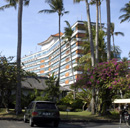
Bali Beach Hotel, the first big hotel in Bali | | 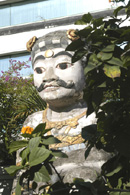
Stone statue at the hotel | | 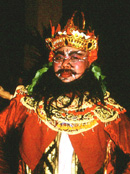
Not a devil but a dancer | | 
Preparing offerings | | 
Procession within offerings | | 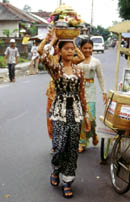
Offering to the gods | | 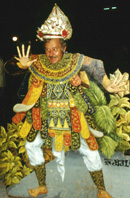
Behind the mask | | 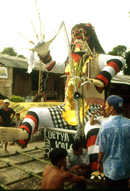
More offerings | | 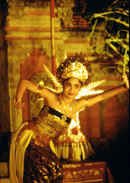
Temple dancer | | 
Bali even has a yacht club | | 
Electrical wires and statues on every junction | | 
Posing for the camera | | 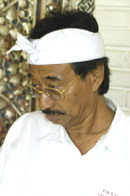
Mr. Neka, founder of the Neka Museum | | 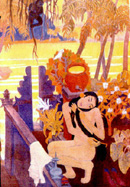
Painting by artist Theo Meier | | 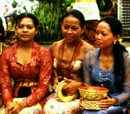
Three women of Bali | | 
The volcanoes of Bali | | 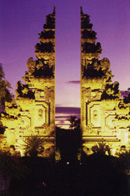
Each village has its temple | | 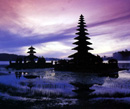
Beauty at every turn | | 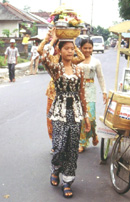
More offerings to the gods | | 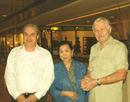
Joerg Kohler, left, Queen Mother of Bhutan, and
Stephens, right |
|





